Char Kway Teow is Singaporean and Malaysian Zi Char comfort food at its best. Flat and wide rice noodles are flash fried with just garlic and chilli and filled with any kind of protein you fancy.
Estimated reading time: 7 minutes

What in the world is Zi Char?
Zi Char is a Hokkien term. It refers to Chinese food stalls found in hawker centres and kopitiams (coffee shops). These stalls may specialise in just one kind of dish, say Hainanese Chicken Rice (recipe soon), for example, or Bak Chor Mee (click for homemade recipe). Or it can sell a variety of different dishes.
Oh, Hokkien is a Chinese dialect that comes from, and is widely spoken in, South East China. This is where a big portion of the Chinese immigrants came from in the 19th century.
You can read more about the various local ethnic groups in Singapore and Malaysia here.
Hawker centres, in case you’re wondering, is a collection of food stalls selling a variety of different foods. Traditionally, these were outdoors (mostly under cover) and represented the local cuisines. These days, they tend to be food courts and air-conditioned.
Char Kway Teow
The name Char Kway Teow is also in Hokkien.
- char = fried
- kway teow = the flat, wide rice noodles (in the West, often sold as hor fun or ho fun, its Cantonese name)
So fried flat rice noodles.
I see some food sites calling Char Kway Teow a South East Asian dish. It’s not, really. I suppose geographically, but that’s about it.
Char Kway Teow is a Singaporean and Malaysian dish of Chinese origin, like the chicken rice and noodles mentioned above. Sure, you’ll find variations of it in the southern parts of Thailand and certainly Indonesia, but that’s because of the proximity of these countries. After all, the Thai border is only a stone’s throw away from Penang, where it most likely originated.
These fried rice noodles started life as something local fisherman would throw together using whatever leftover catch they had, but more often than not, with cockles.
Char Kway Teow with cockles is often also called Penang Char Kway Teow, because that’s where it’s originally from. However, remember Singapore and Malaysia were a single country until 1965? Well, it didn’t take long for the cockle kway teow to make its way down south. It’s definitely one of my favourite hawker foods.
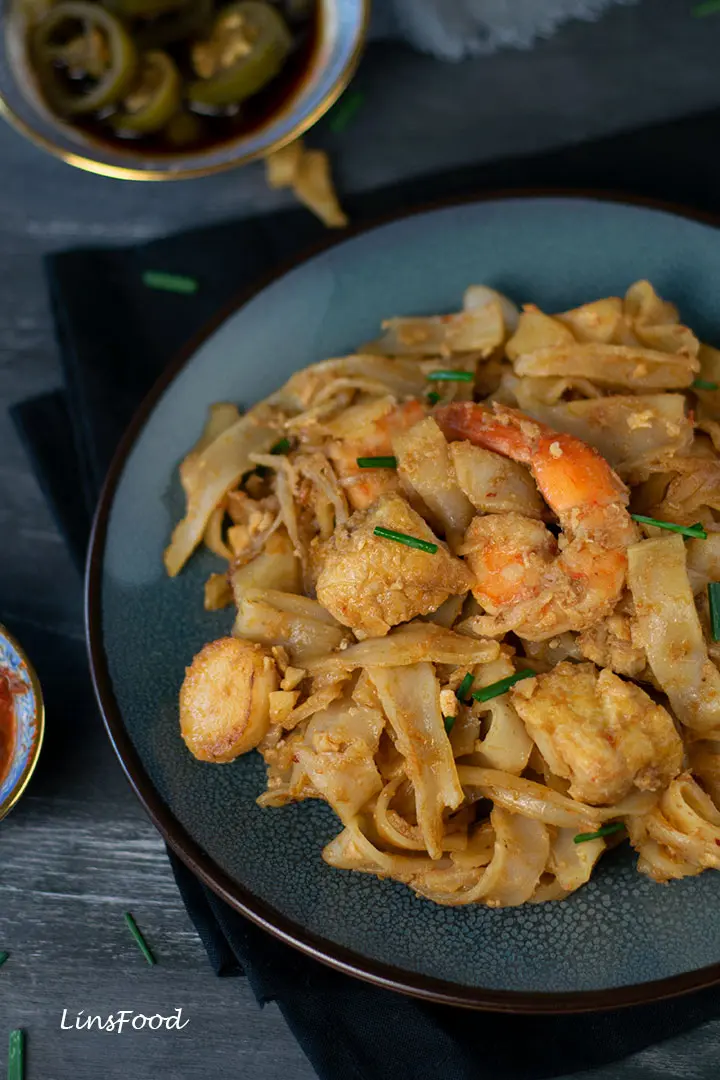
The Noodles (Kway Teow, Hor Fun)
Getting hold of the flat rice noodles is probably the trickiest part of this recipe, depending on where you live. What you want is a Chinese grocer or shop/supermarket. I am within walking distance to a Chinese shop as well as a Korean supermarket. The latter doesn’t sell these noodles, so a Chinese seller is your best bet.
If you don’t have a Chinese grocer nearby, go online.
Here in the UK, the kway teow noodles tend to come in packets of 400g (14 oz), and they are folded over. They are usually in the fridge or freezer section. This amount should be enough for 4 people, bearing in mind that we will be adding protein and vegetables.
You want to soak your noodles in hand hot water for about 10-15 minutes until they’re pliable enough to untangle without breaking too much. The noodles are going to break, no two ways about it, we just have to minimise the breakage.
However, if you are lucky enough to get these freshly made, like we used to, from a wet market, you definitely want those. Soft and silky, they are less prone to breaking.
Char Kway Teow Recipe
Be sure to get all your ingredients ready because the actual cooking time is pretty quick.
Besides the noodles, this dish is pretty straightforward in terms of the other ingredients. Let’s take a look.
Vegetables
Beansprouts are always the vegetables of choice in many, if not most, noodle dishes, and Char Kway Teow is no different. In the recipe here, I’ve only gone with that.
But I also love adding spinach or pak choi from time to time (I cook kway teow a lot).
The Protein
There is a certain amount of leeway with what “filling” you have in your fried kway teow. I’ve gone for prawns (shrimps in the US), Chinese fishballs and puffed tofu. I always have fishballs and puffed tofu in the freezer, these are things I cannot live without.
You can use whatever protein you like, sub them with the same amounts. Here are some ideas:
- cockles
- chicken
- pork
- squid
- mussels
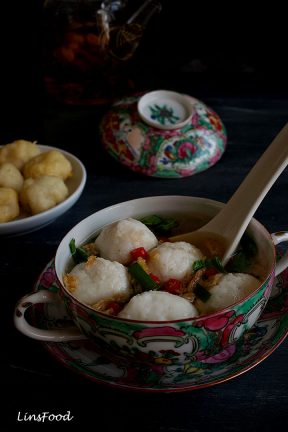

The fishballs I use are homemade, but the puffed tofu are shop bought. And they should be found in most East Asian stores, not being restricted to only the Chinese ones.
If you fancy making your own fishballs, click here for the recipe on LinsFood.
Puffed tofu are tofu cubes that have been drained of as much liquid as possible, then fried, whereupon they puff up. They soak up flavours incredibly well.
You can always use fresh tofu for this. Just cube them, and lightly fry them in a little oil to crisp up before adding to your noodles. This is so your tofu doesn’t fall apart when frying the noodles. And they’re also tastier! Or, you could just leave the tofu out and use something else, see below for suggestions.
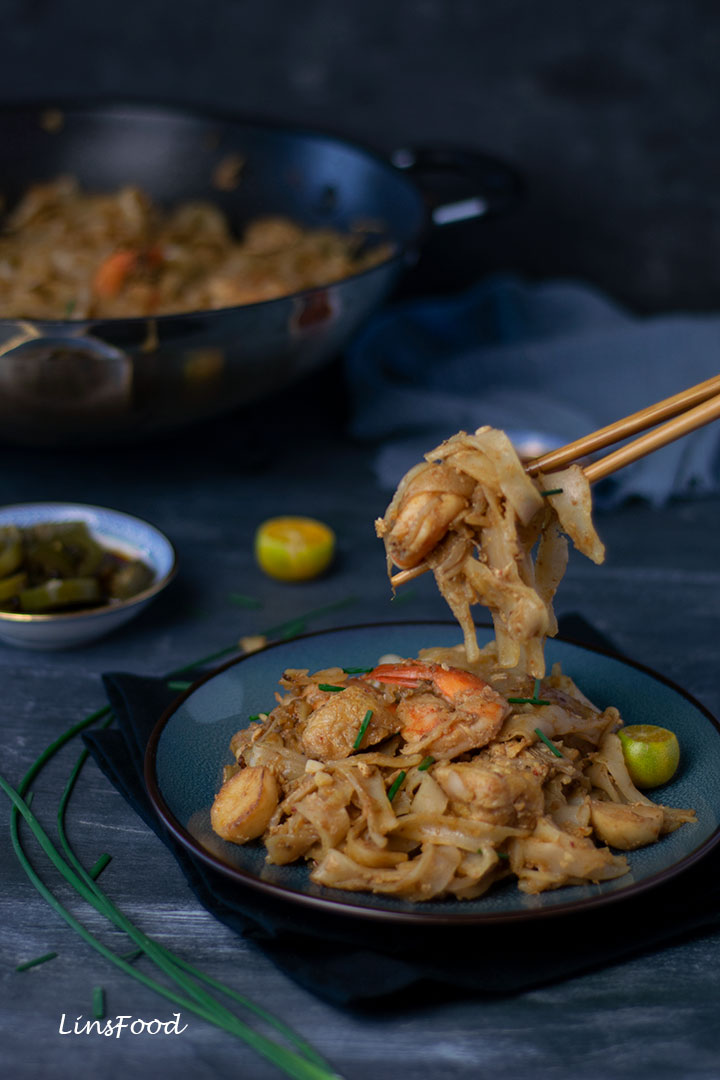
Sauces in Char Kway Teow
We use 3 different kinds of sauces to cook this noodle recipe. If you’ve been a long time follower of LinsFood, you’ll be very familiar with the various soy sauces that are essential in a South East Asian kitchen: light, dark and sweet.
In our char kway teow, we’ll be using light soy sauce, sweet soy sauce and oyster sauce for the flavour base.
Light Soy Sauce
Light soy sauce is thinner and lighter in colour than the others. It is obtained from the first pressing of the soybeans, and its overriding flavour is that of saltiness.
Light soy sauce is used in place of, or in conjunction with, salt, and is also added to dipping sauces, whatever their East or South East Asian origin.
Sweet Soy Sauce
Many people associate this with Indonesian cooking, as it is often sold, in the West, as Ketjap Manis (Indonesian spelling). We call it Kicap Manis in Singapore and Malaysia, which is how it is spelt in Malay.
- Kicap = soy sauce
- Manis = sweet
- Bonus! Kicap tomato = tomato ketchup
Sweet soy sauce is extracted after a long brewing time but it is made with lots of palm sugar or molasses. It is mainly used as a cooking ingredient, not just in stir-fries but also to deepen stews and curries.
Having said that, it can also be used as a dip or condiment, with some freshly chopped chillies and a squeeze of lime juice.
Oyster Sauce
Oyster sauce is made with oyster, salt, and sugar and is salty and a little sweet. When buying oyster sauce, be sure to look for one that has as much oyster extract as possible.
Vegetarian Char Kway Teow
You can make vegetarian char kway teow very easily. Lose the oyster sauce and sub it with dark soy sauce.
Then just use whatever vegetables you fancy. Besides beansprouts, you can use spinach, pak choi, carrots, mangetout, sugar snap peas and mushrooms.
And on that note, shall we get frying?
If you like the recipe and article, don’t forget to leave me a comment and that all important, 5-star rating! Thank you!
And if you make the recipe, share it on any platform and tag me @azlinbloor, and hashtag it #linsfood
Lin xx
More Hawker Centre Recipes
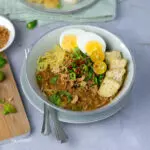
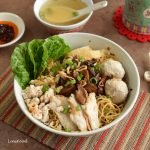
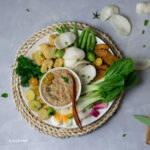

Char Kway Teow (Fried Flat Rice Noodles)
Equipment
- knife
- chopping board
- large bowl for the noodles
- colander
- small bowl for the sauce
- spatula
- work or large, deep frying pan
Ingredients
- 400 g ho fun (flat rice noodles)
- 2 Tbsp vegetable oil
Aromatics
- 4 cloves garlic
- 1 Tbsp any generic chilli paste like this easy Sambal Balado or 2 fresh red chillies
Sauces
- 1 Tbsp sweet soy sauce
- 1 Tbsp oyster sauce
- 2 Tbsp light soy sauce
"Filling"
- 150 g beansprouts
- 100 g fried tofu puffs or fresh tofu, see Notes below
- 100 g fishballs
- 100 g prawns peeled weight
- 2 eggs
Garnish
- chives or spring onions (scallions) chopped
Instructions
Prep Work
The Noodles
- Chances are, your noodles are all bound up. Soak them in hot water for 10-15 minutes until they are soft and pliable. (Hot water: boil the kettle and leave to stand for 5 minutes). The hotter the water, the less time you'll need to soak the noodles.

- Gently unroll the noodles with your fingers, without breaking them, if you can help it. Do this while the noodles are still in the water. If the water is too hot, pour some out, and add some cool water from the tap. The noodles are easier to handle and less prone to breaking while they are submerged.
- Drain the noodles, then drizzle the sweet soy sauce all over, and very gently, coat the noodles with the soy sauce. Set aside until needed.
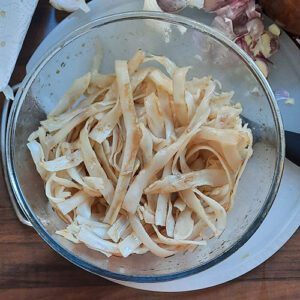
All Other Prep Work
- Finely chop the garlic and red chillies if you are not using chilli paste.

- Mix the light soy sauce and oyster sauce in a small bowl and set aside.
- Lightly whick the 2 eggs and set aside.
- Halve the fishballs and cut the puffed tofu into bite-sized pieces if they are large.
- Chop the chives or spring onions (scallions) and set aside for garnishing the noodles.
Let's fry the Kway Teow
- Heat oil in a large wok over high heat. As mentioned in the post, if you're not too confident about this, cook on a medium heat until you've got the eggs in.
- Fry the garlic and chilli paste (or chopped chillies) for 10 seconds.At this point, depending on how hot your chilli paste is, you may get a spicy aroma filling your kitchen, extractor notwithstanding. If you're not a fan, add the chilli paste with the noodles, as I've done in this image because of my younger kids.

- Add the beansprouts, prawns, fishballs and tofu and mix everything for about 20 seconds.

- Add the sauce mix, and stir vigorously. Fry for 2-3 minutes until the prawns are practically done (mostly red/opaque all over). Keep stirring things around, especially if you are using a high heat.This high heat is what creates that signature slightly smoky flavour synonymous with Char Kway Teow.

- When prawns are practically cooked, push everything to one side and add the eggs. If you started with a medium flame, now's the time to turn it up to high.Swirl the eggs slightly, then, leave to set for 20 seconds. Stir the eggs very lightly, to allow the liquid part to touch the wok, leave to set for another 20 seconds to achieve a soft, semi cooked omelette.The idea behind this is so you'll end up with noodles that are partially coated with egg, but still have bits of egg in the dish.

- Drop the noodles over the half set eggs, and mix everything up with a vengeance! Basically, fry everything, mixing vigorously, scraping the wok to get any sticky bits off and into the noodles.Cook for 2 minutes, until the noodles are done.
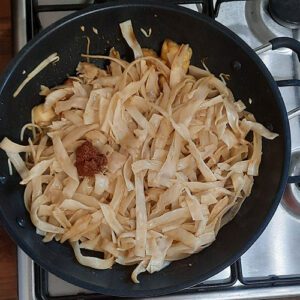
- Scatter the chopped chives all over and serve immediately.
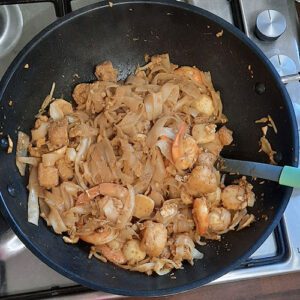

This is amazing! I love kway teow and have never thought to make it myself. What a winner recipe, it went down a treat last night and I can’t wait to cook it up again. Thanks!
I’m so pleased to hear that, Natalie. Thanks for letting me know!
Totally delicious, just like hawker ones!
I’m pleased you think so.
This was so easy! Made it for dinner yesterday and had leftovers for breakfast! So good!
Char Kway Teow for breakfast – one hasn’t lived until one’s done that! Awesome, Anthony!
Thanks, just made this for lunch. Can’t believe how easy it is!
A pleasure, Dane.